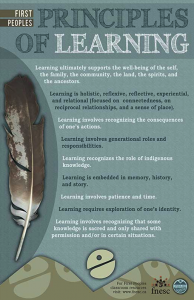First Peoples Principles of Learning/EDUC 446
In my observation practicum, I was lucky enough to sit in on a foods 12 classroom. We had a guest presenter (an ab ed worker at PGSS), come in and show the class how to make bannock. The Ab Ed worker discussed her family past and how she was affected by the trauma of residential schools. The presenter mentioned that her family was not allowed to speak her language, and how she had a mother who was very firm with her because she didn’t want her to amount to nothing. The presenter also mentioned how bannock is not of aboriginal food culture. Bannock originated in Scotland, however, the presenter talked about first people’s food culture and the importance of how it brings everybody together for common interests. The presenter said that food is spiritual, sacred, and inclusive to all people of all backgrounds to come to be together. This experience demonstrated the many different aspects of the FPPL, one of which was that Learning is embedded in memory, history, and story. The teacher of the foods class then showed me the curriculum for foods, and how demonstrating cultural appropriation in the classroom was one of the areas of the curriculum that needed to be covered. Therefore, I thought it was fitting to bring in a presenter for this to provide that learning opportunity for students from someone who has suffered from the dominant people of society in the past. This is an element of teaching that I hope to bring into the class to teach first peoples principles of learning, cultural appropriation, and diversity in my classroom.
Learning First Peoples Classroom Resources – from FNESC
http://www.fnesc.ca/learningfirstpeoples/

EDUC 446
In my learning of the interwoven EDUC 446 course, I have expanded my knowledge on the residential schools into a more global perspective that has allowed me to understand that systemic racism happens everywhere. I learned that the Maori culture has suffered on multiple occasions in the education system of New Zealand. The Treaty of Waitangi supports the rights of the Maori people in New Zealand, which was signed in 1840, but those rights of culture have not exactly been protected from the nineteenth century up until the middle of the twentieth century. Languages were not explored, culture was not expressed, and Maori culture was not educated in the New Zealand Secondary School. In fact, Maori culture made up exactly 1.5% of the curriculum that was supposed to be taught in social studies classrooms at New Zealand Secondary School. Maori culture faced these struggles for over a century, shifting these rights back into the education system at the end of the twentieth century when the Maori tribunal acknowledged that the government had not reinforced the rights of the Maori people. Since I learned this in my class back in block 1, I could not imagine a classroom where I am not working on decolonization and implementing certain strategies in the classroom to mitigate some of the issues that these rights impose. I have learned that I need to create a diverse environment where all youth interests, passions, cultures, backgrounds, and so on are welcomed in my classroom. In my EDU 491 practicum, I was fortunate enough to work as a department with the English teachers with a focus on decolonization and in our discussion, one point really stood out to me, which is how can students ever learn about other indigenous perspectives if they are only taught from one perspective when reading literature. I think this is important to consider when dealing with major societal concepts and keeping decolonizing practices, Maori culture, and especially local culture rights in mind when implementing certain learning actions.